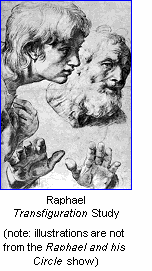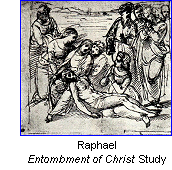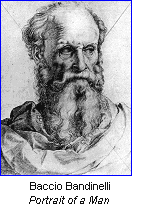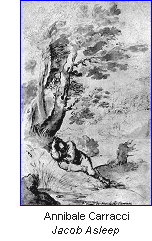
Feature Archive |
September, 2000
The Art of Drawing
| By Joseph Phelan |
A second visit to the Raphael and his Circle exhibit at the Art Gallery of Ontario last weekend persuaded me to write something about the art of drawing this month.
 Without any exaggeration, I found the exhibit of the drawings of Raphael, his father Giovanni Santi, his teacher Pietro Perugino and three of his workshop assistants to be some of the most exciting work I have seen in a long time
Without any exaggeration, I found the exhibit of the drawings of Raphael, his father Giovanni Santi, his teacher Pietro Perugino and three of his workshop assistants to be some of the most exciting work I have seen in a long timeYet a survey of several art-loving friends revealed that none of them was planning to see the exhibit at all. One remarked I don't like drawings, another was disappointed that they're not paintings and a third felt she knew the work of Raphael quite well already thank you very much. This is no way to treat a once in a lifetime exhibit.
Raphael, the prince of painters, has always been admired for his mastery of the art of drawing. It was during the High Renaissance that his (and other artists') drawings began to be collected by connoisseurs like Giorgio Vasari as a key to understanding the creative process. Drawing was considered to be the foundation of the visual arts.
What makes the exhibit so exciting is that although we are dealing with one of the best-loved and most frequently reproduced artists of all time, we are far from being asked to look at overly familiar images. Ranging from quick sketches to large-scale works, these studies reveal the process by which Raphael created his lucid compositions and formulated the poses and expressions of individual figures.
 The exhibit consists of drawings made as preparatory studies for frescoes, altar pieces, tapestries, engravings and works of decorative art. Since some of these works have been lost or were never executed we have here "new" works by Raphael never seen before (several of the drawings have never been exhibited before). And in the case of works which were executed, there are enough significant differences between what exists on paper and what appears on the walls of the Vatican or on canvas in museums around the world to be worth pondering.
The exhibit consists of drawings made as preparatory studies for frescoes, altar pieces, tapestries, engravings and works of decorative art. Since some of these works have been lost or were never executed we have here "new" works by Raphael never seen before (several of the drawings have never been exhibited before). And in the case of works which were executed, there are enough significant differences between what exists on paper and what appears on the walls of the Vatican or on canvas in museums around the world to be worth pondering.Indeed, we are not revisiting Raphael's public work at all. We are looking at his private thoughts, as it were, his first essays for the great frescoes in the Stanze of the Vatican or for one of his beloved Madonnas. The display of these drawings throws open the doors of his workshop and allow us to glance over his shoulder as he figures out the way to compose a Miraculous Draught of Fishes or Massacre of the Innocents.
Drawings are one of the few ways we can rediscover the freshness and spontaneity of the old masters. There is a quality to the best drawings which cannot be duplicated by any other medium. I could swear that some of the figures in the Raphael drawings actually seem to move.
 There is some truth in the notion that the paintings are to the drawings as rhetoric to is to reality. We tend to forget the extent to which great artists like Leonardo and Dürer saw more vividly and more personally then they painted. Certainly from the Renaissance to the end of the 18th century there was enormous pressure on artists to paint the ideal, not the real. With few exceptions, Rembrandt being the greatest, artists did not paint what they saw but what they wished to see or even what their patrons wished to see.
There is some truth in the notion that the paintings are to the drawings as rhetoric to is to reality. We tend to forget the extent to which great artists like Leonardo and Dürer saw more vividly and more personally then they painted. Certainly from the Renaissance to the end of the 18th century there was enormous pressure on artists to paint the ideal, not the real. With few exceptions, Rembrandt being the greatest, artists did not paint what they saw but what they wished to see or even what their patrons wished to see.We are lucky indeed that these priceless scraps of paper were collected and carefully preserved, so that five hundred years later we can feast on their haunting beauty. Drawings unlike paintings are incredibly delicate and would have completely disappeared if they had not been so carefully preserved. For. an example of the kind of damage merely exhibiting a drawing without properly protecting it can sustain see Raphael's sketch for a Last Supper in this exhibit's catalog which has faded almost to nothingness.
While there are many great repositories of old master drawings in art collections around the world (the Albertina in Vienna, the Öffentliche Kunstsammlung in Basel and the Staatliche Museen in Berlin have legendary archives), all too few of these collections are accessible online. This despite the fact that the Internet is without question now the best way to exhibit these works to scholars and the general public. Where else can you put your nose right up to the image or expanded it several times its normal size to capture the fine details?
That is why a number of recent developments on the web are so extraordinary. Surely, the best news is that the British Museum, one of the richest treasure troves of art and artifacts in the world, has recently put over 1,500 works online, many of them old master drawings. Michelangelo, Leonardo, Raphael and Dürer, Rembrandt and Rubens are all here with helpful online commentaries. Next in importance, the J. Paul Getty Museum also has put a huge collection of art online, including most of their old master drawings.
 Other museums which have put substantial parts of their collection online include the Metropolitan Museum of Art, Washington's National Gallery of Art, and the Morgan Library in New York. And to a much lesser extent, the Louvre, Hermitage Museum and New York's Museum of Modern Art have at least made a start at making some of their holdings accessible from their websites.
Other museums which have put substantial parts of their collection online include the Metropolitan Museum of Art, Washington's National Gallery of Art, and the Morgan Library in New York. And to a much lesser extent, the Louvre, Hermitage Museum and New York's Museum of Modern Art have at least made a start at making some of their holdings accessible from their websites.Excellent exhibits of drawings have been star attractions at museums this year although once again without adequate online exhibits. Only the National Gallery of Art in Washington seems to have a consistent policy and perhaps the funding to do this (note the sad case of Canada's National Gallery, which has had to cancel its planned exhibit of Old Masters Drawings). They have exhibited two other collections of drawings, Annibale Carracci, and From Schongauer to Holbein. Unfortunately, the online versions of these exhibits have been removed, so you will have to write to the National Gallery of Art and ask them to please make them available again.
For all those readers whose appetite I've whetted, there is more good news. If you want to learn more about the art of drawing, I can think of no better online exhibit than the current Master drawings from the Cleveland Museum of Art. Some of the greatest examples known of this art are on display. This website provides a curator's tour of the exhibit which uses pairs of drawings to show how style, technique and subject matter reflect both the continuity in the tradition over five centuries as well as the innovations and changes in the history of art. There is also a detailed analysis of the different drawing techniques represented.
Raphael and his Circle
Drawings from Her Majesty the Queen's Collection at Windsor Castle
Art Gallery of Ontario: August 5 - October 15 2000
J. Paul Getty Museum: October 31 2000 - January 7 2001
Other online resources:
This article is copyright 2000 by Joseph Phelan. Please do not republish any portion of this article without written permission.
Joseph Phelan can be contacted at joe.phelan@verizon.net